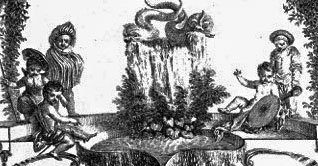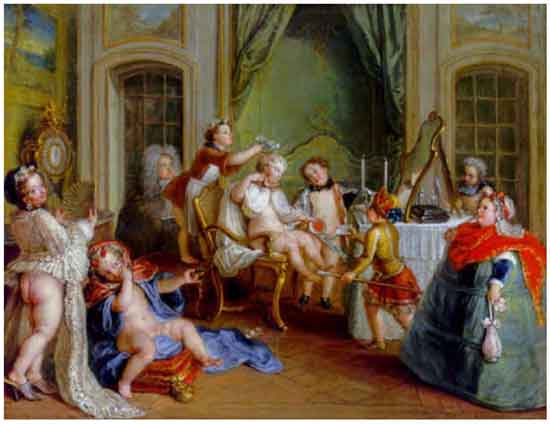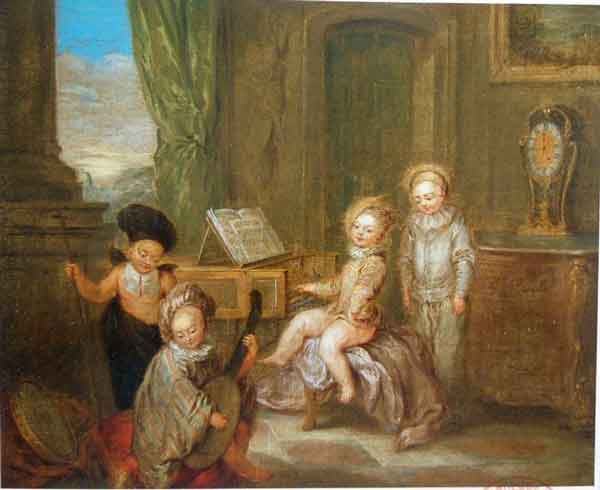
- Home Page
- Accepted
Paintings & Copies - Doubtful
Attributions - Doubtful Textual References
- Alternative
Titles - Collectors &
Museums - Bibliography
- Search Abecedario
- Watteau &
His Circle
X. Les Enfants musiciens
Entered November 2014
Whereabouts unknown
Oil on canvas
29 x 35 cm
ALTERNATIVE TITLES
Baby Musicians
Concert of Babies in Costume
PROVENANCE
Monaco, Sotheby’s, June 21, 1986, lot 45: “Antoine Watteau . . . LES ENFANTS MUSICIENS. Porte l’inscription A.W.F. vers le milieu à gauche / Huile sur toile. 31,5 x 36, 5 cm. Dans une gravure arabesque de Watteau entitulé <<Les Enfants de Momus>> et datable vers 1706-1708 se retrouvent deux des enfants dans pratiquement les mêmes positions (il s’agit du premier enfant à gauche et du Petit Pierrot à droite). Bibliographie: Jacques Mathey, Antoine Watteau, peintures réapparues, Paris 1959, p. 28, reproduit fig. 34. Ettore Camesasca, Pierre Rosenberg, tout l’oeuvre peint de Watteau, Florence1968, Paris 1970, p. 124, no 1C, dans la section <<autres oeuvres attribués à Watteau>>, non vu par les auteurs. 200 000 / 300 000 FF.” Sold for 288,600 francs.
New York, collection of Roberto Polo (b. 1952, investment banker).
New York, Sotheby’s, January 11, 1990, lot 88: “Circle of Antoine Watteau . . . LES ENFANTS MUSICIENS / bears inscription lower right A.W.F./ oil on canvas / 11½ x 13¼ 29 x 35 cm. / Two of the figures in the present picture are also in an engraving by Watteau entitled ‘Les Enfants de Momus’. The engraving is datable to circa 1708-09. Provenance: Sale: Sotheby’s, Monaco, June 21, 1986, lot 45 (as Watteau) Literature: Jacques Mathey, Antoine Watteau, peintures réapparues, 1959, p. 28, illus. fig. 34. Ettore Camesasca and Pierre Rosenberg, Tout L’Oeuvre Peint de Watteau, 1968 and 1970, p. 124, no. 1C. $15,000-20,000.” The painting was bought in.
SELECT BIBLIOGRAPHY
Mathey, Watteau, peintures réapparues (1959), 28, 66, cat. 34.Watson, “Watteau, Peintre Inconnu” (1962), 126.
Macchia and Montagni, L’opera completa di Watteau (1968), cat. 1o-C.
REMARKS

Despite the unwarranted optimism surrounding this painting when it came to light after World War II, supposedly as work by the young Watteau, it suffered a subsequent fall from grace. The dramatic drop in sale price between when it sold in at auction 1986 and 1990 vividly registers the justifiable loss of faith of this work. The purported presence of Watteau’s initials (located differently in the two sales) cannot be taken seriously since Watteau never signed his paintings. The imagined relationship between this work and Watteau’s Enfants de Momus is superficial; any similarity between the two Pierrots merely reveals that stock characters from the commedia dell’arte were invariably shown in characteristic poses, irrespective of the artists portraying them.
In his review of Mathey’s book, Francis J.B. Watson rightly questioned the dating and attribution of Les Enfants musiciens to Watteau. He focused on the Regency commode at the right side of the composition, and pointed out that this piece of furniture demonstrated that the painting could not date c. 1707-08 as Mathey posited. Watson argued that the furniture could not have been designed until no earlier than the very end of Louis XIV’s reign, c. 1715, and so the picture could only have been executed near the end of Watteau’s career. But, pushing the chronological boundary further, Watson doubted that such furniture was ever produced in Watteau’s lifetime with the consequent conclusion that the picture must have been painted by someone else.

Watson’s observations were directly on target. The painting must have been executed closer to c. 1730-40, in other words, a decade or more after Watteau’s death. Indeed, the style of the figures and its comedic sense are closely related to the work of Charles Antoine Coypel (1694-1752). His painting of Children Parodying a Lady’s Toilette, signed and dated 1728, offers significant visual analogies. The two parodic subjects have much in common, especially in spirit. The saucy, half nude girls in the lower left of Children Parodying a Lady’s Toilette recall the gesture and coquettishness of the girl at the clavier. The quality of Les Enfants musiciens is not as high as Coypel’s painting, suggesting that it might be only a copy of an otherwise unrecorded Coypel composition. Certainly it is much more closely related to Coypel's work than it is to Watteau's.
